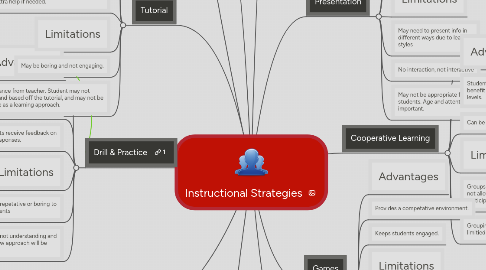Instructional Strategies
da Kristen Kenny


1. Drill & Practice
1.1. Advantages
1.2. Small amounts of information can be practiced, giving students opportunities to try it out.
1.3. Students receive feedback on their responses.
1.4. Limitations
1.5. May seem repetative or boring to some students
1.6. If student appears to be not understanding and making same errors, a new approach will be needed.
2. Simulations
2.1. Advantages
2.2. Hands on
2.3. Provides a safe environment
2.4. Students of different ability levels can participate
2.5. Limitations
2.6. May not truly represent actual event
2.7. May require too much time to complete.
2.8. Idea may be too complex.
3. Tutorial
3.1. Advantages
3.2. Self paces, and students can work independently.
3.3. Some programs will respond to students progress and allow them to begin a new topic, or offer extra help if needed.
3.4. Limitations
3.5. May be boring and not engaging.
3.6. No guidance from teacher. Student may not understand based off the tutorial, and may not be effective as a learning approach.
4. Discovery
4.1. Advantages
4.2. Very engaging
4.3. Can use steps or processes that have been previously learned.
4.4. Limitations
4.5. Time may become a factor
4.6. Sometimes preparation can be very critical. Teachers must think about any issues they may run into,
5. Discussion
5.1. Advantages
5.1.1. Opportunity for new ideas.
5.1.2. May be more interesting than sitting and listening, more engaging.
5.1.3. Limitations
5.1.4. Not all students will participate.
5.1.5. Younger students may not follow along as well
5.1.6. Some questions may pose to difficult for some, or may not be challenging enough.
6. Advantages
7. Demonstration
7.1. Advantages
7.2. Students will see how its done before they do it.
7.2.1. Session Rule 1
7.2.2. Session Rule 2
